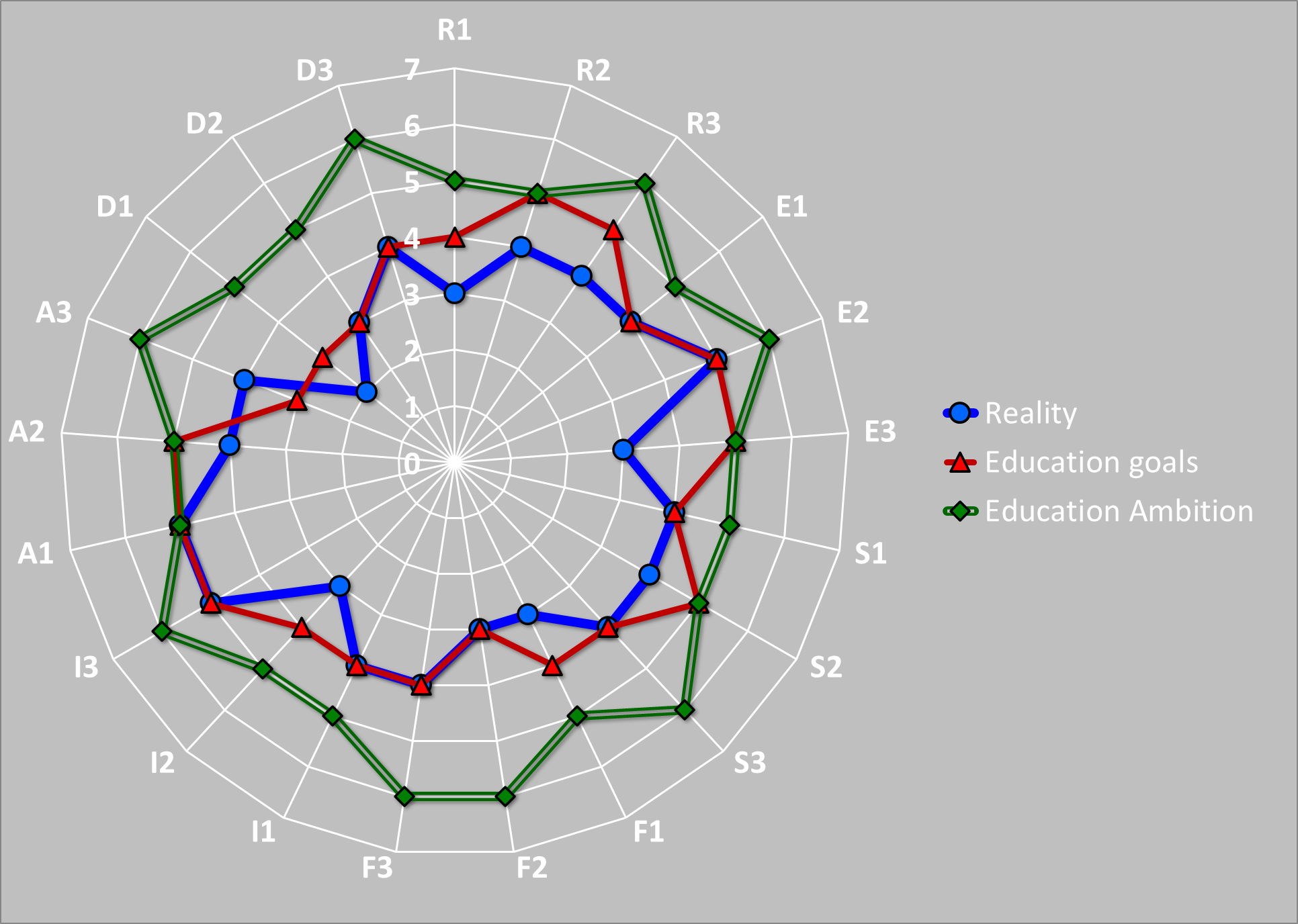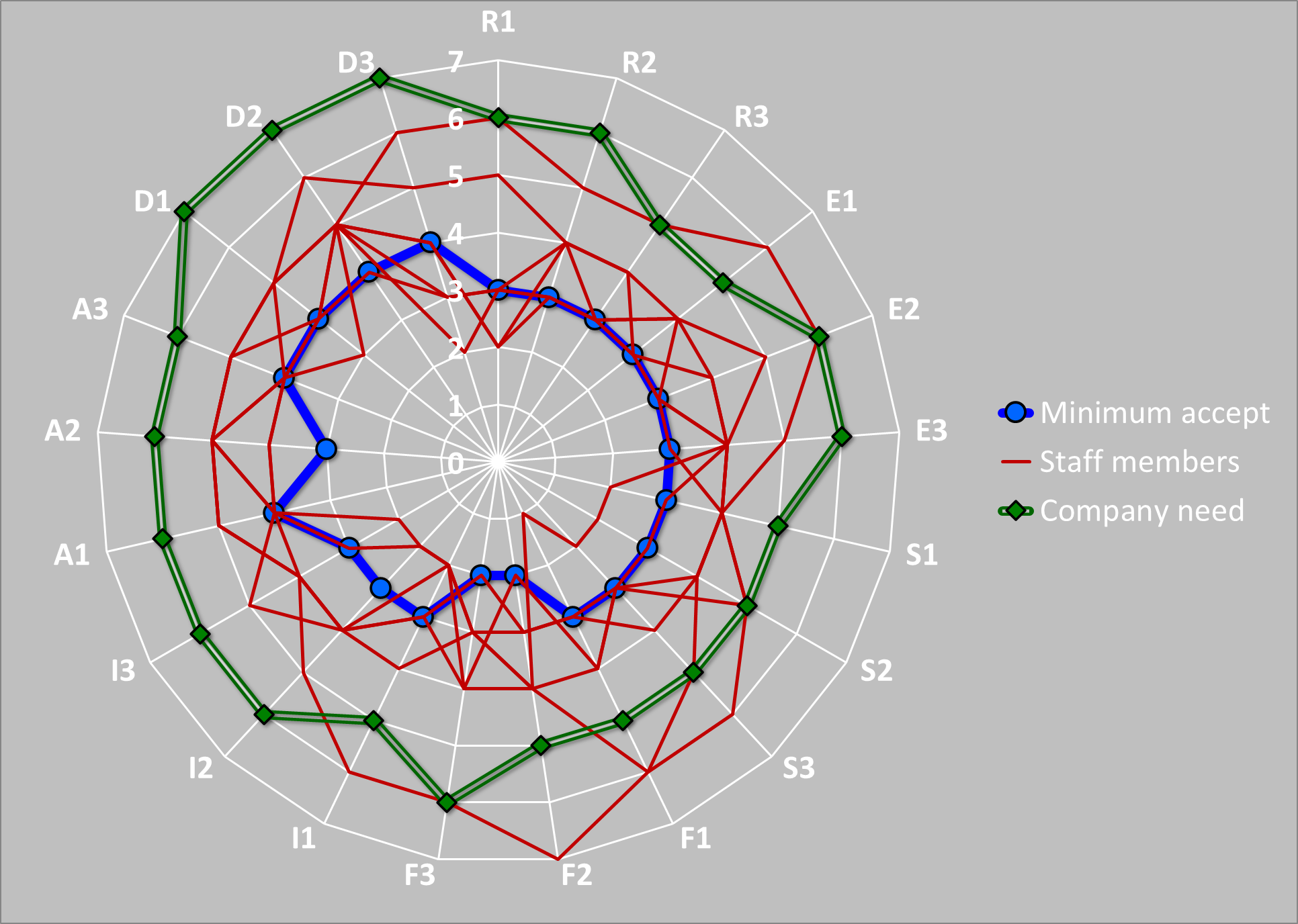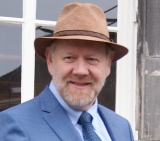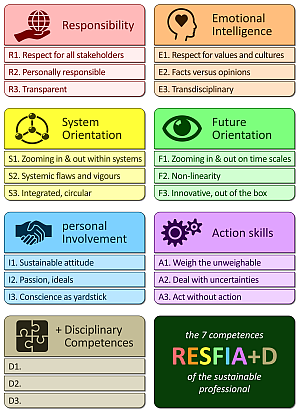RESFIA+D: Sustainability Competences; Manual for the Application |
> Go to the page range where all details and scientific backgrounds of the RESFIA+D management method are described: |
Assessment Tool for Sustainability Competences RESFIA+D is a management method for the assessment and improvement of professional competences related to sustainable development. The RESFIA+D method belongs to: In these books, the method is described in Chapter 12 and the Appendix. > See also the introduction to RESFIA+D in Dutch or in German. RESFIA+D is applied in three ways. For all three of them, the method paves the way to create strategic plans for the integration of sustainable development. > On this page: - Origins and structure of RESFIA+D - RESFIA+D for Individual Professionals and Students, creating a - RESFIA+D for Universities, Colleges and Schools, to create or improve - RESFIA+D for Companies, Teams and Organisations, to create or |
Figure 12.01: The 7 competences of RESFIA+D |
> On the next page: an assessment report from the practice of an educational institution.
> On other pages: - The Sustainably Competent Professional, an explanation of the basic concept - Theoretical backgrounds of RESFIA+D - The Seven Competences, a summary in English, German and Dutch - Levels of Competence, ranging from the Apprentice to the Master - The Seven Competences, a one-by-one description in English: see on the right ------> - Spectral Completeness of RESFIA+D - Disciplinary Competences, an example: The Sustainably Competent Educator - Stories from Real Life > For more information; see the Bibliography: - Books: Roorda (2010; 2015); Roorda & Rachelson (2018) - Journal articles & Chapters: Roorda (2016); Roorda & Rachelson (2019) |
Origins and structure of RESFIA+D
In books and articles, often two kinds of roles of individuals are described: the citizen and the consumer. For a responsible citizen, driving no more than 65 mph on a highway seems like a pretty fair speed, and eating healthy food appears important. However, as a consumer, the same person may wish to drive faster, and not just to buy responsible food in the supermarket but also those nice and shiny, sweet or spicy snacks. It is a constant struggle: the sensible citizen versus the easily tempted consumer.
Actually, both have opportunities to act sustainably. The citizen may vote conscientiously and participate in discussions to support civic organizations. The consumer may carefully use electricity and water or buy fair trade products, sustainable fish, and FSC-certified wood – and never more than needed.
However, there is a third role: the professional. RESFIA+D addresses those professionals.
Sustainability in the professional world
It is true that many books and websites dealing with sustainability in the professional world have been introduced. However: nearly without exception, they are about companies and organizations as a whole. Nevertheless, in the end, anything those businesses or institutions do is the work of separate individuals. Those professionals – ranking high or low in the organization, from CEOs and top managers to production employees, administrative staff, nurses or janitors – all matter. About them, the individual professionals, not much has been written yet. The roles of the individual professionals are extremely important because:
Every decision made by a company, government, or organization is ultimately taken by human beings.
All actions undertaken by a company, government, or organization are always performed by human beings.
RESFIA+D is dedicated to all of those people: individuals at work.
RESFIA+D: The seven competences of the sustainable professional
For those individuals, a set of competences was designed by Niko Roorda, and first published in 2010 in his PhD Thesis.
The set is called “RESFIA+D”, which is an abbreviation. The first six characters, “R‑E-S-F-I-A,” represent general competences, i.e. those that may be expected from any professional: ‘Responsibility’, ‘Emotional intelligence’, etc.
The seventh, “D,” is short for “Disciplinary.” That is to say: related to separate professions or disciplines.
Six general competences; Eighteen achievements. And a multitude of disciplinary competences
RESFIA+D consists of seven competences. Six of them are ‘generic’ competences, which means that they are relevant for every professional. The seventh is called ‘disciplinary.’ Actually, this is an infinitely large group of competences linked to all kinds of specific sectors and professions because there is potentially an unlimited number of professions.
The Seven Competences of the Sustainable Professional are shown in the above table. Each of the six generic competences is expressed in terms of three types of concrete professional achievements. As an example, Competence E, emotional intelligence, comprises these three achievements:
E1. Recognise and respect their own values and those of other people and cultures
E2. Distinguish between facts, assumptions and opinions
E3. Cooperate on an interdisciplinary and transdisciplinary basis
See also the image at the top of this page, which lists the achievements in an abridged formulation.
Seven competence levels
Professionals are either sustainably competent, or they are not? Of course not; that would be an oversimplification. In reality, it is more complicated; with respect to a variety of competences, some persons are more competent, while others are less so. A person may be a well-educated and experienced professional who is held in high esteem by everyone or a novice who has learned quite a few things but doesn’t have much practical experience yet. A suitable model is the medieval concept of the master and the apprentice. The former has mastered the profession deeply. The latter is only allowed to work, for the time being, under the supervision of the master. He or she still has to acquire more skills and is not yet considered highly competent in the discipline.
To describe the sustainability competence levels, RESFIA+D applies more than just the two competence levels of the medieval guilds. Seven levels are distinguished: they are desctibed in detail on this page.
Application
Together, the seven competences and the seven competence levels form an assessment instrument. The instrument is a rubric.
| Rubric: an instrument widely used in contemporary university and vocational education to assess performance and skills and to provide feedback, in the form of a list of criteria, provided with a scale of points or level descriptions from low to high, which indicate how each criterion is well met. See the Bibliography: Reddy & Andrade (2010); Stevens & Levi (2012); VU (2023). |
|
In order to complete the assessment, guidelines for the application have been developed. There are three types of applications: by individuals; by educational institutions; and by companies and other organisations.
The first application is by an individual professional. It might be the reader, a colleague, a supervisor, a staff member, or an intern. Students can do it, as a part of their study program in a university, a college, or a school.
The assessment can be done repeatedly, for instance every one, two or three years, as a part of a cyclic professional development process.

A result of an assessment of an individual professional or student
Preparation
Download the scoring spreadsheet for individual assessments in English.
Step 1: Your present competence, according to yourself
First, you go through all six generic competences one by one; and for each of them, you go through the three achievements that are defined.
> As an example: see the achievements of the first competence: R, Responsibility.
If, as a preparation, a set of disciplinary competences has been defined for your profession (e.g. by an expert group, by the organization you work for, or by you yourself), you include those as well.
> As an example, see the Educator competences.
For each of these 18 or more achievements, you sincerely ask yourself, after reading the detailed level descriptions: Do I really do this, or at least do I do things that are comparable with these descriptions? At which level do I do it?
Don’t fool yourself by being too optimistic; why would you?
Step 2: Feedback from others
Next, you invite one or more persons who are familiar with you and your work and whom you trust to score the 18 or more topics with you in mind. If enough people do this, you get a 360° feedback.
Of course, if you cannot or don’t wish to get this kind of feedback, you can leave Step 2 out.
Step 3: Your ambition
Then, you define your ambition for each of the achievements. Before you do, you might select a certain period of time in which you want to realize this ambition: i.e. a target date. Where would you want to be by then?
The result will look like the above figure, which is an actual result, scored a few years ago by a Dutch professional working as an ESG consultant.
Step 4: Personal Development Plan
After you complete the assessment, you use the results to think about how you can realize your ambition; that is: create a Personal Development Plan (PDP).
First: define your priorities. It may not be a good idea to try and realise each and every desired progress, all at the same time.
Then: Select methods to raise your competence levels. Elements may for instance be: Expand your practical experience. Interview experts, in order to learn from them. Read a book. Do an internship, play a serious game, investigate internet pages. Accept coaching. Enroll for a course or even a full study program. Get certificates. Find a new job, or even transition to a new career.
Make your plan achievable: find facilities to realise it. Consider for instance: time, money, equipment, teachers, permissions.
Optional: Leadership
In addition to the assessment, you can take a Leadership Qualities Test: the LQ-Test, the results of which can contribute to your personal development plan.
Next
Repeat the assessment some time later, for instance after one or two years, thus creating a PDCA cycle (Plan - Do - Check - Act) for your continuous personal development.
RESFIA+D has been applied many times in educational institutions, for study programs and their curricula. You can think of scientific and vocational education, in universities, colleges and schools.
The method has been used for a wide variety of disciplines, e.g. technological, economic, social, agricultural, healthcare, law and teacher education.
If a curriculum is to be (re)designed, this process should always start at the end, that is by (re)defining the desired outcomes of the study program, formulated as a set of competences of the graduates. This is where RESFIA+D comes in.
When the competence profile is defined in a proper way, the curriculum contents as well as the curriculum structure and didactic methods can be derived from it. Top down, so to say.

A result of an assessment by the team of a study program (BSc) in a university
Preparation
Download the scoring spreadsheet for education assessments in English.
Optional: Define disciplinary competences
If the team of the study program judges it to be relevant or even essential, it can define a set of disciplinary competences, including their competence level descriptions.
Before doing so, it is smart to make a comparison with the existing general competences, and with the example of the set of disciplinary competences that is offered on this website.
> As an example: see the achievements of the first competence: R, Responsibility. Next, see the Educator competences.
In the example of the Educator competences, three achievements of the educator are defined, which is equal to the number of achievements for each general competences; but that is actually a coincidence. The number of three achievements is not necessary; it is perfectly possible to define less or more achievements. However, please note:
> If you design less or more than three disciplinary achievements: please mind that, in that case, the scoring spreadsheet has to be adapted accordingly.
Step 1: Compose an assessment group
As a preparation for the assessment, a group of circa ten to fifteen people is formed. Together, they have to be representative of all those who are stakeholders of the study program.
Another demand for each of the group members is that they are sufficiently familiar with the current curriculum or, if no curriculum exists yet, with the demands from the professional field or the academic world, and from society in general in relation to the study program.
The group will consist of:
- lecturers, professors;
- learners, students;
- program managers, deans and/or even the institution board;
- recent alumni (with a fresh memory of the entire study program) – unless the program is brand new;
- and experienced representatives of the academic or professional field the study program aims at.
And possibly, if relevant:
- representatives of society in general, e.g. community leaders;
- education financers;
- representatives of special interest groups, e.g. representing minorities or the environment.
Step 2: Create consensus on present state and ambition
The group meets only once, for half a day or a few hours more. At the beginning, the assessor (someone who is highly experienced in applying RESFIA+D for this purpose) explains the goals and structure of the assessment method and the purpose of the meeting.
Next, the assessor goes through all 18 achievements of the ‘RESFIA’ part, i.e. the generic competences, one by one. If disciplinary competences were defined beforehand, they are applied as well. For each of the 18 or more achievements, the assessor asks three questions, which the group discusses until consensus is reached. No voting allowed!
The questions are:
- For this specific achievement, which is the competence level each student should at least have acquired when graduating?
In other words: which ambition should the study program strive for? - Which is the level that is demanded in the present competence profile?
That is to say: what does the program currently demand? - And which level is actually achieved by each and every graduate at the very least?
Thus: what is the present reality?
In many cases, the answers to those three questions will be different. It is not uncommon that the group concludes that the ambition for a certain achievement should be, for example, Level 6; while the profile of the program demands perhaps Level 5, and the level that is actually realized, at least by some graduates, may be Level 4.
The overall result will look like the above figure, which was an actual result of the assessment of a study program (Bachelor of Commerce) in 2014.
Step 3: Select priorities
After the group has reached consensus (majority voting should never be applied!) on the answers to the three questions for all 18 or more achievements, its task is nearly finished. What remains is setting priorities for an improvement project.
The strength of the assessment is that it is not some external expert who is going to tell the study program team that their program is not good enough. If there are differences between the ambitions and the present state – and there always are – it is the members of the group, including those who are responsible for the program, who draw the conclusions. They themselves determine the necessary improvements; they are the ones who give themselves a task. They own the conclusions.
On the other hand, there may perhaps be as many as 15 or more improvements that are to be realized. But you probably know that any plan with more than – say – three or four main goals is bound to fail. That is why it is important to select a limited set of highest priorities, out of all suggested improvements. Usually this appears to be an easy task. Each desired improvement has been discussed in detail. The group will probably know already, which of them are crucial first steps, and which others will follow easily as a result of the crucial first improvements.
Selecting the priorities is usually done in ten minutes.
The result, which is to be turned into a report, formally has a status of recommendations to the management. Of course, the managemers are likely to accept and embrace these recommendations, since they participated in the discussions, and the conclusions were drawn in consensus. It is a truly democratic process, creating a lot of support and enthusiasm.
Step 4: Create an Education Development Plan
The final step will be for the management, i.e. for those people who carry the responsibility for the quality of the study program.
Preferably, the management team meets the very next day, when memories of the assessment are still fresh. During this meeting, the set of recommendations is turned into a solid Education Development Plan.
This plan arranges how and when the current competence profile will be adapted, followed by the necessary changes to the curriculum. The plan will involve a time schedule, a budget, the responsibilities of those who are going to do the actual work, their facilities, etc.
It will also contain an overview of the competences that the education team will need in order to be able to develop the improved program and to teach it. Consequently, a new staff development plan may be needed, if not all necessary competences are present within the team. If so, RESFIA+D may again be useful, this time along the lines of individual assessments, described above.
Optional: Leadership
In addition to the assessment, one or more staff members may be asked to take a Leadership Qualities Test: the LQ-Test, the results of which can contribute to the staff development plan.
Next
After the plan is constructed, a period follows in which it is executed. At the end of this period, another round may follow in which RESFIA+D is applied again, leading to new conclusions, and so on. In this way, a PDCA cycle (Plan - Do - Check - Act) of continuous improvement is closed.
Optional: AISHE; SD Curriculum Scan
> See also two other management methods for education development, that are often applied in combination with RESFIA+D:
AISHE; and the SD Curriculum Scan.
RESFIA+D has also been applied in companies and other organisations, both in profit and non profit organisations. The method is applicable in a wide variety of sectors and industries, e.g. production, finance, consultancy, healthcare, education, government, research, law, NGOs.
Under the supervision of the board or the management, the assessment is organised and coordinated by the HRM department, aiming at Human Resource Development (HRD): of a team, a department, or the entire organisation.
In the course of the assessment, all or a selection of the staff members of the selected organisation department will participate: e.g. the consultants, the teachers, the doctors and nurses, the financial staff, the salespersons, the top & middle managers.

A result of an assessment by the HRD department of a company
Preparation
Download the scoring spreadsheet for organisation assessments in English.
Step 1: Minimum acceptable level
As a start, an individual minimum requirement may be defined. This is a set of 18 (or more, if disciplinary competences were defined) levels that are the lowest acceptable level for anyone within the team.
Step 2: Company need
At the other end, also an ambition level is defined for the entire team, describing what the company needs. This does not require every team member to meet the demands of this ambition; it involves the combined strength of the team as a whole.
It may, for example, be decided that each ambition level needs to be possessed by at least one or two team members; if not, the team may not be able to perform its tasks properly.
Step 3: Individual assessments
All team members – or at least those who were selected for the assessment – do the individual assessment, as described above. In this case, the 360° feedback should definitely not be left out.
After the individual assessments are finished, the result will look like the above figure.
Step 4: Staff Development Plan
Based on this result, the team – or its managers – will develop a Staff Development Plan. This plan describes how the team is going to meet the formulated ambition within a limited period of time, e.g. a year.
This may be based on negotiations with individual team members, resulting in agreements that certain members will follow courses, perhaps in-company, while others will find different ways to develop themselves.
For those team members who don’t meet the minimum demands, such a development plan is especially important; if it were to fail, it might ultimately lead to a dismissal procedure.
Optional: Leadership
In addition to the assessment, one or more staff members may be asked to take a Leadership Qualities Test: the LQ-Test, the results of which can contribute to the staff development plan.
Next
After the plan is constructed, a period follows in which it is executed. At the end of this period, another round may follow in which RESFIA+D is applied again, leading to new conclusions, and so on. In this way, a PDCA cycle (Plan - Do - Check - Act) of continuous improvement is closed.


